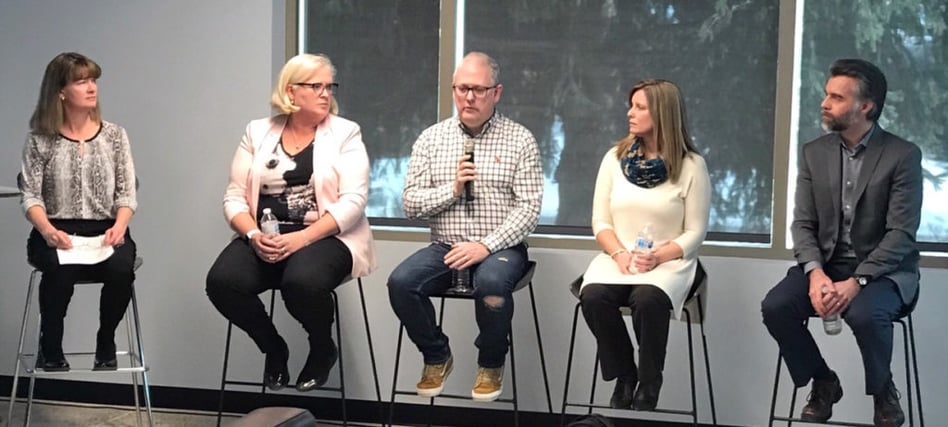This article was published more than 1 year ago. Some information may no longer be current.
How Will You Fight Churn? (Part 1)
With Firefighters or Power Yoga?
By guest bloggers Graham Cowen, Jennifer MacIntosh, Leah McGuire, Jean-François Pouliotte and Stratford consultant Lauren Thibodeau
If you’re part of the Software as a Service (SaaS) ecosystem, you know that churn is the archenemy. So how do you fight it off? By calling in expert firefighters to do battle? Some companies take this approach, relying on firefighting employees to douse the flames of churn as they flare up. Others however, like the seasoned practitioners at a recent Customer Success (CS) & Customer Experience (CX) panel, recommend a more Zen-like power yoga approach, where you pro-actively stretch to keep muscles loose, and systematically extinguish churn before it flares up.
But first, why is it so important to reduce churn, and how can strong CS/CX practices help?

|
Simply put, reducing churn makes good business sense. And elevating your CS/CX practices directly impacts your bottom line and increases long-term company value. Consider these stats:
|
SaaS Ottawa Meetup’s Lauren Thibodeau recently sat down with Graham Cowen of You.i TV, Coveo’s Jennifer MacIntosh, Leah McGuire of Kinaxis, and Assent Compliance’s JF Pouliotte to talk proven practices in CS/CX.

L to R: Lauren, Jen, Graham, Leah, JF
| There were no firefighters, no flames, just a wide-ranging discussion on CS and CX practices that really work to fuel customer success and crush churn, and a surprise cameo appearance from a Kanata North neighbourhood deer. |  |
Like most panels, we didn’t get through all the questions we had prepared, so we wanted to share the Q and A with you here.
1| Some of you have Customer Success (CS) in your title, others have Customer Experience (CX). How would you differentiate between CS and CX or would you? Which one comes first in your opinion?
Jen: I’ve been fortunate to do both roles in my career. I look at it like this: Customer Experience defines the program(s), Customer Success executes on that promise.
Leah: For me CX is the important first step, what is the vision you want to fulfill. Mapping and understanding your customer’s journey, including what gaps exist in their experience, helps to build and grow a Customer Success organization that addresses those gaps and as Jen said, executes on the CX Vision.
Graham: For me, CX is the orchestration of the overall customer journey, ensuring the experience is effectively designed. CS on the other hand, is ensuring that as the customer progresses along that journey, that they are successfully achieving their business objectives and growing into promoters, advocates, and references.
2| To help us understand what success looks like, could you share a key metric or two that your CX/CS org is measured on and why?
JF: Net Revenue Retention is one of the most telling indicators of success for a subscription-based business. It informs us of how much recurring revenue we are getting from the group of customers we had 12 months ago (assuming you have annual contracts). The ability to expand and not only retain your accounts is very top of mind for investors as well, up there with net new growth and gross margin, so be ready to talk about it. Of course, it is a lagging indicator so you need other metrics to help you understand the health of your business and mitigate risk, such as NPS, adoption, etc.
Leah: Net Revenue Retention for sure and Customer Advocacy, ie. How willing are our customers to speak on our behalf.
Graham: Customer LTV & ARR; Churn Rate (customer & revenue); Transactional CSAT; Customer Health (NPS, engagement, sentiment, project health). As Corporate level goals, we have NPS, Developer Satisfaction and Product Affinity, though we’re still trying to work out the best way to measure that last one.
Jen: Customer Retention Cost (CRC) is another good one. Many organizations focus on Customer Acquisition Cost (CAC), but measuring the cost of retaining a customer is also an important component of a balanced view.
3| Industry leading Customer Success vendor Gainsight published their 7 laws of customer success. #4 is “Not all customers are created equal. To scale you need to segment and prioritize.” Could you share how you do this at your company practically speaking?
Leah: Practically speaking, I recommend you develop a simple way to segment your customers using revenue and other factors such as market vertical and strategic importance. Then determine how you’ll interact with each customer segment.
Graham: We look at whether this is a program level engagement vs. a single project, the value of the deal (licensing and services), technical complexity, and whether this is the first time implementing a particular type of solution. From a CS perspective, we then dedicate resources in a different manner depending on these factors.
4| Law #6 is “It’s not CSs job to make customers happy. CSs job is to make customers successful and the least likely to churn.” Can you share how you make sure you don’t confuse unhappy, demanding customers with successful customers, at low risk of churning.
Graham: For us it’s always about referring back to the customer’s business objectives and asking whether we are helping them get there. We need to be able to have the hard conversations that sometimes may make the customer “unhappy” but lead them to a better result overall and we need the skills of our CSMs to be able to navigate through those waters and build trust to have those conversations. It’s still a people game.
Leah: A solid, well-rounded picture of customer health helps to dig in to areas of risk and really understand whether the customer is about to churn.
5| Customer Success Managers. Do you have them? Are they deep subject matter experts, or do they bring in SMEs as needed?
Jen: Our CSMs are “T-shaped” people, meaning that they have a wide reach in terms of their ability communicate with different levels across our customers’ organizations. At the same time, they are subject matter experts in Knowledge & Content Management, while also having strong Coveo technical skills.
Graham: Because of the very technical nature of our product (it’s designed for developers), we look for our CSMs to have deep expertise in Customer Success, and to bring in the deep technical experts in the company at the right time. We don’t expect CSMs to be developers. The CSM’s core responsibilities are to ensure our customers meet or exceed their business objectives, drive day to day customer engagement, identify risks to satisfaction and success, and drive action plans to address these risks.
So there you have it. The first half of a wide-ranging perspective on Customer Success and Customer Experience tips and proven practices, that successful CS and CX leaders recommend to help elevate customer success and drive business value for customers.
If you’re in the Ottawa area, please join us at a future Meetup.
Sign up here:
You May Also Be Interested In: How Will you Fight Church – With Firefighters or Power Yoga (Part 2)
Bios

|
Graham Cowen has over 20 years of progressive customer care and customer success leadership in the software industry with companies such as Adobe and Conceptshare. Now Director of Customer Success at You.i TV, Graham continues to shake up the status quo of customer care, creating results for a disruptive company. |

|
Jennifer MacIntosh is a self-proclaimed dot-connector, helping people across her organization understand customer journeys. Jennifer was recognized as one of the Top 50 Women in SaaS in 2018. She is an active industry collaborator with the Consortium for Service Innovation, and board member of TSIA and the Association of Support Professionals. |

|
Leah McGuire is a Customer Experience leader with Kinaxis who is passionate about driving a customer first culture. Her years working as a supply chain practitioner and consultant give her a strong ability to empathize with her customers and bring their perspective to the forefront. |

|
Jean-François Pouliotte is the VP of Customer Success at Assent Compliance, the global leader in supply chain data management. WE ARE HIRING! Check out our careers page at https://www.assentcompliance.com/careers/. |

|
Lauren Thibodeau is a Customer Experience and Strategy consultant with Stratford, where she helps SaaS companies crush churn and maximize recurring revenue. She co-organizes the SaaS Ottawa Meetup, and the Ottawa Customer Success & Customer Experience Meetup. |
References:
- Don’t Spend 5 Times More Attracting New Customers, Nurture Existing Ones (Forbes)
- The Value of Keeping the Right Customers (Harvard Business Review)
- The Essential Guide to Customer Success (Gainsight)
- Customer Retention (HubSpot)
- Three Leading Causes of Churn (Retently)
- Gainsight Elements: The Science of Customer Success (Gainsight)
- No Churn: Keep Customers and Improve Your SaaS Company Valuation (SaaS Capital)
This article was published more than 1 year ago. Some information may no longer be current.
